Posted: Wednesday, August 20, 2025
How Starlink Satellites May Obscure the Universe’s Earliest Signals

Starlink satellite sends signals in nearby frequencies, creating a lot of radio frequency interference that can spill over into crucial cosmic channels.
Ever since the moment the first photons of the cosmic microwave background noise of the universe began its journey through the universe, astronomers have been tracking their faint signals to unravel the story of creation. Yet today, a new obstacle looms in low Earth orbit. SpaceX’s Starlink constellation, with its thousands of gleaming satellites, may be casting an unintended shadow over the deep-sky signals that carry secrets from the universe’s infancy.
At radio frequencies, the glow of neutral hydrogen during the cosmic dark ages should whisper across our receivers at around 21 centimeters in wavelength. But each Starlink satellite transmits in adjacent bands, producing a forest of radio frequency interference that can bleed into these precious cosmic channels. Even low-level leakage can drown out the tenuous ripples of early structure formation that scientists hope to detect.
Optically, the threat is no less serious. As far as twilight is concerned, satellites will catch and reflect sunlight causing an effect that makes the sky into an unblinking mirror of busy activity. This activity washes across the night's sky, saturating sensitive imaging arrays with streaks and flares that obscure the light of distant galaxies and nebulae. For observatories, seeking to catch the earliest light, every surge in brightness is a lost fragment of time’s primordial tapestry of the universe.
Beyond the glare and static, there’s a cumulative impact on data integrity. Sophisticated observing campaigns rely on long integrations—hours or even nights of continuous observation—to tease out the subtlest signals. When a swarm of satellites sweeps overhead, those observations fragment, introducing gaps and anomalies that cannot be easily patched in software. The results are maps and spectra with blind spots, leaving cosmic dawn studies perpetually incomplete.
Certain researchers propose that collaboration and technical modifications could reduce the negative effects. Tweaking satellite schedules, calibrating transmission levels, and applying absorbent coatings helps to reduce both radio and optical interference. Meanwhile, astronomers are creating adaptive filtering algorithms and real-time satellite tracking systems to avoid disruptions before they impact critical measurements.
Ultimately, this challenge underscores a larger conflict between humanity's desire to link every part of the world and our wish to maintain clean, unobstructed views of the universe. If Starlink and upcoming satellite groups aim to exist alongside astronomical research, they need to acknowledge that the universe’s ancient light is just as crucial to our shared heritage as any earthly communication network. With thoughtful preparation and discussions, researchers make certain that the narrative of the universe's beginnings reaches us with unimpeded and unchanged data.